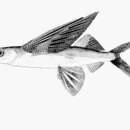Diagnostic Description
provided by Fishbase
Body dark iridescent blue above, silvery white below; pectorals black with pale margin, central portion crossed by a yellowish stripe becoming narrower toward anterior fin margin; pelvic fins with prominent black spot (Ref. 6797). Body of juveniles with dark bars (Ref. 6797).
- Recorder
- Cristina V. Garilao
Migration
provided by Fishbase
Oceanodromous. Migrating within oceans typically between spawning and different feeding areas, as tunas do. Migrations should be cyclical and predictable and cover more than 100 km.
Morphology
provided by Fishbase
Dorsal spines (total): 0; Dorsal soft rays (total): 13 - 15; Analspines: 0; Analsoft rays: 8 - 11
- Recorder
- Cristina V. Garilao
Trophic Strategy
provided by Fishbase
Inhabits surface waters of the open ocean, capable of leaping out of the water and gliding for long distances above the surface (Ref. 3395).
- Recorder
- Grace Tolentino Pablico
Biology
provided by Fishbase
Inhabits surface waters of the open ocean, capable of leaping out of the water and gliding for long distances above the surface (Ref. 3395). Planktivore (Ref. 97629).
Importance
provided by Fishbase
fisheries: minor commercial; price category: medium; price reliability: very questionable: based on ex-vessel price for species in this family
Cheilopogon nigricans
provided by wikipedia EN
Cheilopogon nigricans, the blacksail flyingfish, also known as African flyingfish, or leaping flyingfish, is a flying fish in the family Exocoetidae. It is an oceanodromous, plankton-eating marine fish which has commercial value.
Description
Like many other flyingfishes, the blacksail flyingfish has a cylindrical body and large pectoral and pelvic fins that it uses for gliding flight. Most adults are roughly 28 cm long and are generally dark iridescent blue above, silvery white below. Pectoral fins are black and with a yellowish stripe in the middle. Pelvic fins have prominent black spot, which can clearly identify the species. Juveniles are different from the adults by the presence of dark bars on body. It has 13 to 15 dorsal soft rays and 8 to 11 anal soft rays.[2]
Distribution and habitat
The blacksail flyingfish is a widely spread fish that can be found tropical water of Indian, West Pacific and parts of Atlantic Oceans. It can be seen along Brazil, South Africa, Madagascar, Sri Lanka, India, Pakistan, Bangladesh, Sumatra, Indonesia, Japan, Taiwan, Fiji, Borneo, and Australia.[2]
See also
References

- license
- cc-by-sa-3.0
- copyright
- Wikipedia authors and editors
Cheilopogon nigricans: Brief Summary
provided by wikipedia EN
Cheilopogon nigricans, the blacksail flyingfish, also known as African flyingfish, or leaping flyingfish, is a flying fish in the family Exocoetidae. It is an oceanodromous, plankton-eating marine fish which has commercial value.
- license
- cc-by-sa-3.0
- copyright
- Wikipedia authors and editors
Description
provided by World Register of Marine Species
Inhabits surface waters of the open ocean, capable of leaping out of the water and gliding for long distances above the surface (Ref. 3395).
Froese, R. & D. Pauly (Editors). (2023). FishBase. World Wide Web electronic publication. version (02/2023).
- license
- cc-by-4.0
- copyright
- WoRMS Editorial Board

